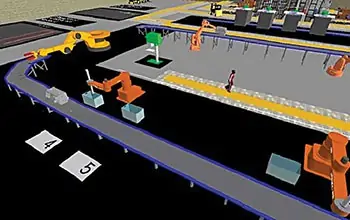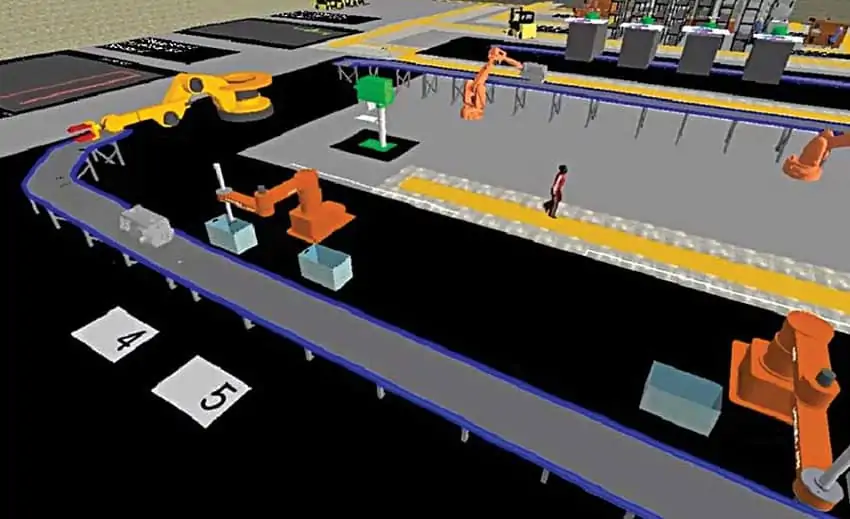
(Source: Simio via AssemblyMag)
In general, a business process would play out through multiple, different events in sequence.
As an example, let’s think about a logistics chain involving a truck:
- it arrives at a warehouse;
- it enters a loading gate;
- it unloads its supplies;
- and then it leaves the warehouse.
In the example above, you will see that each step is a separate — i.e., discrete — event. In order to simulate this process, you will typically use a discrete event simulation model.
In this post, we take a look at 4 trailblazing discrete event simulation examples.
Discrete Event Simulation Examples
1. F-35 Fastener Prep & Kitting System (FastPAKS)
The F-35’s wing assembly process requires mechanics to prepare fasteners.
However, the challenge with this process is that it consumes too much time and that the fasteners (when they’re chemically treated) have a shelf-life of 5 days. So building out an inventory is not an option; the end-to-end process of treating and installing the fasteners must occur quickly.
The goal of the F-35 Fastener Prep and Kittening System (FastPAKS) is to sort and prepare fasteners for the fighter’s wing assembly at a faster rate. Simio implemented a discrete event simulation model to observe FastPAKS process from 2018 to 2022.
Simio’s simulation found that the FastPAKS proposal would increase fastener installation rates to 98.4% (same-day installation).
2. Nebraska Medical Center
The Nebraska Medical Center opted to re-examine its surgical facilities, i.e., University Tower and Hixson-Lied Building. It also wanted to plan for its new facilities, e.g., the Comprehensive Cancer Center, Eye Center, and Ambulatory Center.
According to Simio, the Nebraska Medical Center had wanted “to determine the optimal future location(s) for specific patient populations based on prioritized operational goals.”
The Center opted to implement a discrete event simulation model to study its proposals and to see how it could achieve the aforementioned objectives.
Using the model, the Center simulated its current system in a virtual environment and used the insights to identify and remove bottlenecks, reduce patient and surgeon travel distance, ensure the use of operating rooms during staff peak hours, and reduce patient turnover.
Use Simulation Modeling to Find & Remove
Unnecessary Cost Drivers
3. Cosan
Based in Brazil, Cosan is the world’s top sugar and alcohol exporter. In turn, Cosan is also the world’s leading producer of residual waste resulting from sugarcane production.
Cosan’s agriculture logistics team was tasked to find ways for reducing the company’s capital expenditure (CAPEX) requirements. To achieve this goal, Cosan tagged the following areas of its logistics chain in need of change:
- Ascertain the “optimum” number of transport vehicles it needs to transport sugarcane materials to its sugar processing mills while lowering costs.
- Identify how it can increase the mills’ sugarcane capacity.
- Identify and remove production bottlenecks and “improve the flow of (sic) sugar cane.”
Cosan opted to use discrete event simulation modeling covering 240 days “factoring in labor variations, unplanned downtime, non-optimal equipment speeds, and other uncertainty.”
The purpose for selecting discrete event modeling was that it mirrored the company’s real-world dynamics and, in turn, enabled it to reduce its CAPEX spending.
4. Nissan NV200 Van Production
Nissan Motor Iberica SA in Spain has been using discrete event simulation modeling since 2015 to closely monitor and optimize its NV200 van production site.
The facility’s engineers are using the simulation model to monitor each of the facility’s different assembly lines (e.g., for the chassis, the body/frame, etc). Its supply chain experts are utilizing the same simulation to ensure that the facility’s throughput matches with market demand.
More on How Simulation Modeling Generates Key Business Insights:
- Alphabot: A Case Study in Use Of Simulation For Product Feasibility Analysis
- 7 Key Advantages of Simulation for Business
- Case Study: Crude-by-Rail Transload Terminal Simulation
A major benefit of discrete-event simulation — and other simulation models — is that companies from practically any industry can use it to acquire the insights they need to boost profit. But one of its major challenges is that it isn’t easy to implement without the tools and expertise.
You must have simulation and modeling experts who know how to proficiently use tools such as Simio and AnyLogic, for a start. However, you need research experts who understand how your business functions and its realities as well.
This is not easy (nor quick) to build in-house, but the market is always moving, even when you are not. However, you can move quickly by completing your simulation work with the help of an outside consulting firm.
At MOSIMTEC, we help businesses in complex industries — including mining, logistics and manufacturing — simulate their current and future environments to identify costly risks and opportunities for boosting revenue. Meet (or pass) your quarterly goals by calling us today.
